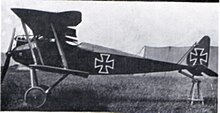Halberstadt D types
The Halberstadt D-types were German fighter planes in the First World War , which were mainly used by the German air force.
development
The Halberstadt DI, designed by Thomas Voigt at Halberstädter Flugzeugwerke at the end of 1915, was intended to be a possible successor to the Fokker monoplane . The prototype, a two-stemmed biplane, first flew in February 1916, but underwent numerous modifications before the machine went into series production: the wings were staggered forwards, the side coolers removed and a surface cooler attached to the upper wing instead, the pilot's seat raised and the fuselage is enlarged upwards due to the higher cockpit . The second prototype D.Ia also received a 120 hp Opel Argus engine. As with the Fokker and Morane monoplanes , instead of a conventional elevator, there was a fully controllable pendulum rudder . Another feature was the rudder, also designed as a pendulum rudder, which is typical of Halberstadt-D aircraft and which was attached to two tubular steel struts in the middle.
The first order for 12 series machines was received on March 21, 1916 for Halberstadt D.II, which is equipped with a 120 hp Mercedes D-II engine . In addition to Halberstadt, Aviatik and the Hannoversche Waggonfabrik each produced 30 aircraft under license. Like the Fokker E.III, the D.II had a synchronized MG that was shifted to the right.
The D.III and D.IV differed from the D.II mainly by the larger balanced ailerons, the semicircular wing cutout above the cockpit and by the 120 HP Opel -Argus or the 150 HP Benz Bz III engine. The DV, the last Halberstadt single-seater, was to compete with the Albatros single-seater , was equipped with the 120 hp Opel Argus engine and had a streamlined bow with a small propeller hood. The D.IV and DV also had the option of installing a second MG, which, however, overwhelmed the machine in terms of performance due to the additional weight.
commitment
The fighter aircraft proved to be maneuverable in the hands of experienced pilots and so stable that it could withstand even high dive speeds. When the Halberstadt D.II appeared on the front in June 1916, it proved to be only slightly faster and more climber than the monoplane and thus remained inferior to the opposing Nieuport 11 and DH2 , but was inevitably the best fighter aircraft until the appearance of the Albatros DI German side. 85 D.II were delivered. It served primarily as an escort fighter for the heavier reconnaissance aircraft, but in addition to the albatross hunters also formed the basis of the newly established fighter squadrons.
About 500 D aircraft of all five types were delivered. In January 1917 about 100 D.II and D.II were in use, but were gradually withdrawn from use in favor of the Albatross hunters. In Macedonia and Palestine, however, they remained in use for longer. Some DV were delivered to the Ottoman Air Force .
Technical specifications
| Parameter | DI | D.II | D.III | D.IV | DV |
|---|---|---|---|---|---|
| Construction year | 1915 | 1916 | 1917 | ||
| Intended use | Fighter plane | ||||
| crew | 1 | ||||
| number of pieces | 25th | 200 | 60 | 100 | 120 |
| length | 7.30 m | 6.70 m | |||
| span | 8.80 m | ||||
| height | 2.66 m | ||||
| Wing area | 24.00 m² | ||||
| Empty weight | 520 kg | 536 kg | 561 kg | 525 kg | |
| Takeoff weight | 730 kg | 746 kg | 771 kg | 737 kg | |
| water-cooled 6-cylinder in- line engine | Mercedes DI with 105 PS | Mercedes D II with 120 hp | Opel - Argus As II with 120 hp | Benz Bz III with 150 hp | Opel -Argus As II with 120 hp |
| Top speed | 150 km / h | 185 km / h in NN | |||
| Climbing time to 1000 m | 4 min | 3 min | |||
| Climbing time to 2000 m | 9 min | ||||
| Ascent time to 3000 m | 15 minutes | ||||
| Service ceiling | 4500 m | ||||
| Range | 250 km | 200 km | |||
| Flight duration | 1:30 h | ||||
| Armament | 1 LMG 08/15 | ||||
See also
swell
Individual references / comments
- ↑ Peter Alles-Fernandez (Ed.): Aircraft from A to Z / 2, Consolidated PBY - Koolhoven FK 55. Bernard & Graefe, Koblenz 1988, ISBN 3-7637-5905-0 .
- ↑ a b AERO , issue 89, p. 2488
- ↑ very different figures; here the information from: Günter Kroschel, Helmut Stützer: The German military aircraft 1910–1918 . Lohse-Eissing, Wilhelmshaven 1977, ISBN 3-920602-18-8 .
literature
- Enzo Angelucci (Ed.): World Encyclopedia of Military Aircraft. Jane's, London et al. 1981, ISBN 0-7106-0148-4 .
- Karlheinz Kens, Hanns Müller: The aircraft of the First World War 1914–1918 . Heyne, Munich 1973, ISBN 3-453-00404-3 .
- Günter Kroschel, Helmut Stützer: The German military aircraft 1910–1918 . Lohse-Eissing, Wilhelmshaven 1977, ISBN 3-920602-18-8 .
- Kenneth Munson: Warplanes. Fighter and training aircraft 1914–1919 . Füssli, Zurich 1968, ( Aircraft of the World ), No. 18.
- Heinz Nowarra: The Development of Airplanes 1914–1918 . Lehmanns, Munich 1959.
- Anthony G. Williams, Emmanuel Gustin: Flying Guns. World War I and its aftermath 1914–32 . Airlife, Shrewsbury 2003, ISBN 1-84037-396-2 .
